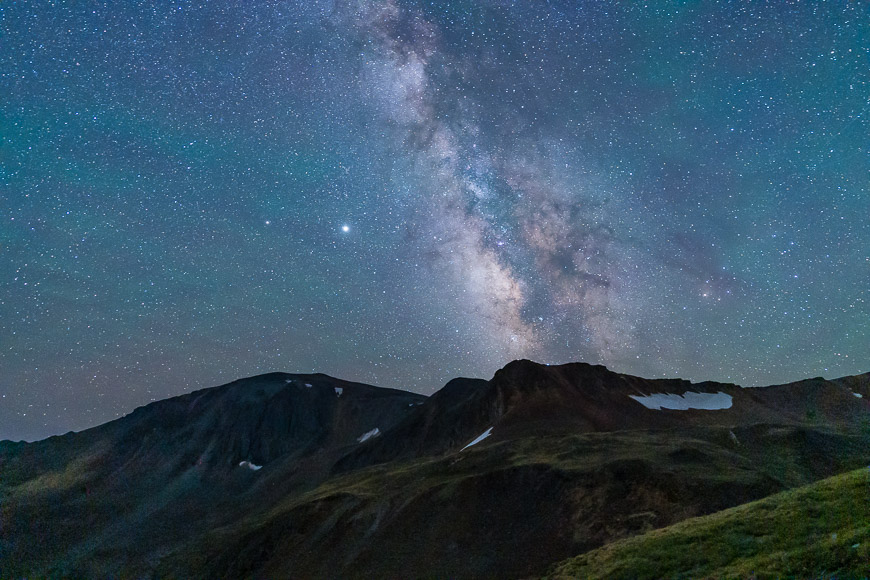
This article will discuss the best lenses for astrophotography in 2025.
If you’re passionate about capturing stunning night skies through your lens, you’re in the right place.
I’ve been a fan of capturing the stars for as long as I can remember, and I’ve come a long way in my ability to do it well.
The right lens makes a huge difference when photographing stars, galaxies, and celestial events.
When my friends ask me how to take better star photos, my first question for them is what gear they’re using.
Before we can even talk about how to take star photos we have to know that our camera and lens are capable.
In this article, I’ll share my top lens picks for astrophotography enthusiasts and professionals alike.
3 Top Lenses for Astrophotography
When shopping for an astrophotography lens, first and foremost, you’re going to want a wide-angle focal length for capturing vast star fields like the Milky Way.
Then, you’re looking for wide apertures for low-light performance and to keep your shutter speeds lower.
That would be something like f/2.8 or faster.
Additionally, you want sharpness across the frame to avoid coma and distortion.
And lastly, you might want to consider weather sealing for outdoor use in varying conditions.
Below are my top choices for superior sharpness and light-gathering capabilities.
Most of my selections are going to be prime lenses, but I will include some zoom lenses since they’re versatile enough to be used for other things as well.
In some cases, there are fewer wide-angle primes for mirrorless Canon RF and Nikon Z mounts because they’re newer, whereas Sony will have more choices.
1. 14mm f/2.8
With astrophotography, my goal is often to capture as much of the vast night sky as possible.
I sometimes aim to include some of the surrounding landscape elements as well.
If you’re lucky, you can even get a small amount of moonlight to illuminate the earth (avoid a full moon or when the moon is high in the sky).
This means that, sometimes, wider is better when we’re looking to capture the vastness of the Milky Way.
The 14mm lens allows you to use its ultra-wide angle to capture expansive and dramatic nightscapes.
Its wide aperture handles low-light conditions superbly.
However, the extreme width of this lens can make celestial objects appear smaller, or it can include unwanted elements in tighter compositions.
Choose this lens for the widest vistas, including big landscapes and wide-open skies.
14mm DSLR Options
14mm Mirrorless Camera Options
2. 20mm

The 20mm strikes a balance between the wide coverage of the 14mm and more natural framing.
This lens offers less distortion, making it ideal for foreground details and landscapes with stars.
You can get creative with your framing and foreground, telling more of a story.
The wide aperture ensures sharp, bright spots in low light.
However, this lens might not capture as much of the sky as the 14mm.
Choose this lens for balanced shots with less distortion and a more versatile field of view.
20mm DSLR Options
20mm Mirrorless Camera Options
3. 24mm

The 24mm lens is a versatile option and one that you might already have in your kit for other purposes.
24mm provides a natural field of view that’s perfect for Milky Way photography.
Again, the wide aperture ensures bright, noise-free images even in dark conditions.
This lens is wide enough for landscapes with a more natural perspective.
Since it has a narrower field of view compared to 14mm and 20mm, it may require more planning.
Also, because it’s a popular focal length, there are more choices available for newer mounts like the mirrorless Canon RF and Nikon Z.
24mm DSLR Options
24mm Mirrorless Camera Options
Best Lenses for Astrophotography by Camera Brand

Best Nikon Lenses for Astrophotography
Best Canon Lenses for Astrophotography
Best Sony Lenses for Astrophotography
FAQs
Can you do astrophotography with any lens?
Yes, you can use almost any lens for astrophotography, but wide-angle, wide-aperture lenses with minimal distortion work best for capturing vast, clear, and bright night skies.
Is 50mm better than 85mm for astrophotography?
A 50mm lens is more versatile for wide star fields and landscape elements, while an 85mm lens is better for focused shots of celestial objects but less practical for broader compositions.
Should I use a telephoto lens for astrophotography?
Telephoto lenses are used for capturing detailed shots of the moon, planets, and deep-sky objects but are less suitable for wide-field starry landscapes.
Can you do astrophotography with a 35m lens?
Yes, a 35mm lens can be used for astrophotography if you’re looking to balance wide coverage with foreground elements.
What is the best focal length for the Milky Way?
Wide-angle focal lengths between 14mm and 24mm are ideal for capturing the Milky Way in all its grandeur while including surrounding landscapes.
Should I use manual or autofocus for astrophotography?
Manual focus is preferred for astrophotography because it allows you to make precise adjustments on distant stars.
This can be challenging for an autofocus system to do in low-light conditions.
Do I need a wide-angle lens for astrophotography?
A wide-angle lens is my go-to for astrophotography because it allows you to capture more of the expansive night sky in a single frame. It’s especially useful for photographing the Milky Way, star trails, or wide landscape scenes beneath the stars.
While you can use other focal lengths for specific types of astrophotography, a wide-angle lens is a versatile and beginner-friendly choice.
Conclusion

I hope this helped you choose the best lens for astrophotography to add to your kit.
Capturing the night sky, Milky Way, or meteor showers can be a fun and challenging endeavor, but it’s almost always worth it!
Some of my favorite images have been captured in the late night hours and sometimes you get rewarded with unexpected sightings like wildlife or meteors.
If you have any questions about a particular lens, leave a comment down below!
Credit : Source Post



